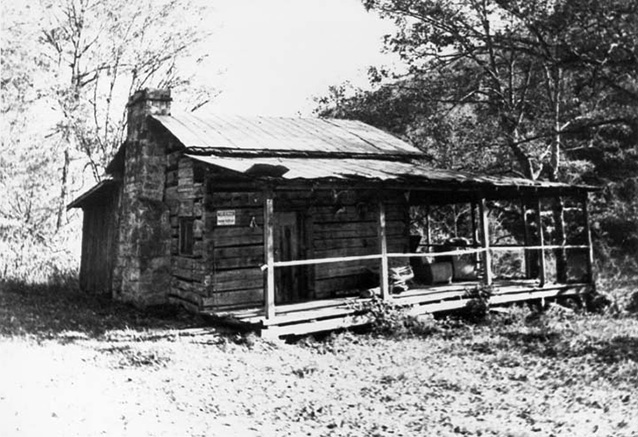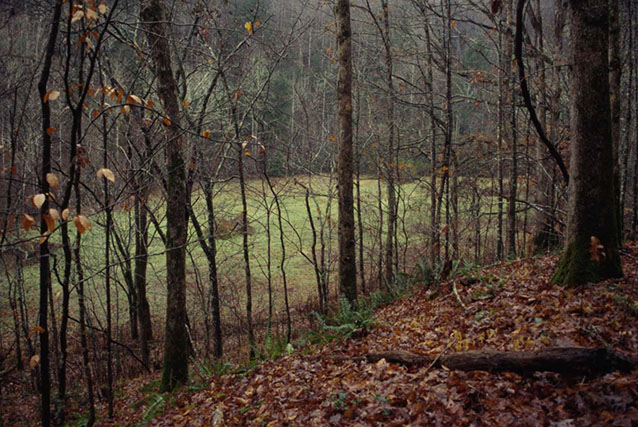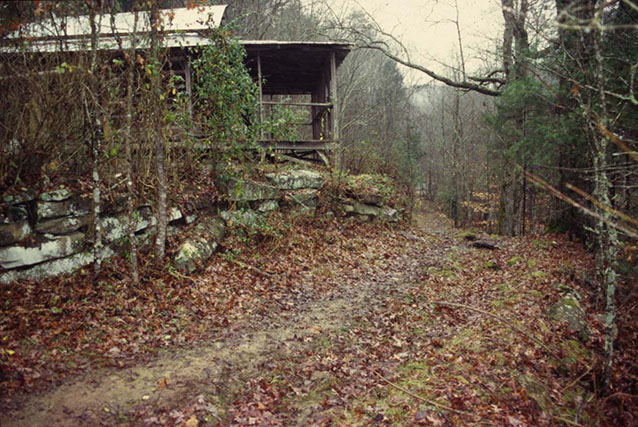The Parch Corn Creek Farmstead is a 51.65 acre landscape located on Parch Corn Creek in Scott County, Tennessee. The property lies completely within the Big South Fork gorge. The house on the site, built in 1881 by John Litton for Armpstead Blevins, was destroyed by fire in March 1998.

NPS (Cultural Landscapes Inventory, 1998)
The farmstead still contains many features typical of a 19th century Cumberland Farmstead in the gorge, including: remnant fields; chimneys and possible chimney falls; foundations of former structures; an outhouse; a rock ledge and spring; a stone wall remnant; historical road traces and the Helen Blevins grave.
The period of significance for the site begins in 1881 with the construction of the log cabin by John Litton for Armpstead Blevins and his family. The period of significance ends in 1974, with the establishment of Big South Fork National River Recreation Area.
According to tradition, the Blevins family moved to Big South Fork in 1820 from Virginia (what is now West Virginia), settling first in Wayne County, Kentucky, and then moving to Parch Corn Creek in Scott County, Tennessee. It is believed that the family had a gristmill at Parch Corn Creek during this time to grind corn. John Litton, a twenty-three year old farmer, built the story-and-a-half, single-pen, log house at the site for Armpstead and Helen Blevins.
The sixteen-foot by sixteen-foot structure was built on sandstone piers. The exterior chimney was also constructed of cut sandstone. Armpstead, a farmer, was sixty-three years old at the time, and Helen was forty-six. They had five young children living at home. In 1913, Helen Blevins died and was buried at Parch Corn Creek. Two of her sons, Houston and Jacob, continued to live at the homestead for some time after their mother's death. It is believed that Jacob stayed at the site for about eighty years, roughly until the 1960s. Over the years, the cabin mostly retained its original character.

NPS (Cultural Landscapes Inventory, 1998)
The loss of the house significantly impacted what was previously the most intact cultural landscape at the park. The grave and other remnants at the site are in danger of succumbing to forest succession. The western field is still mostly free of invasive vegetation. The field closest to the homesite was overgrown, with a significant number of young trees encroaching, but has been cleared in recent years.
Parch Corn Creek Farmstead is a part of the proposed Big South Fork Rural Historic District. The Big South Fork Rural Historic District is significant at the state level for its association with the early settlement, agriculture and rural community life, and economy of the Upper Cumberland region in Tennessee; for its many examples of vernacular folk architecture once typical of the region; and for its potential to yield information important to understanding the historic human occupation of the area.
The diverse resources of the district are united historically and physically by their association with farming activity and rural life in the Upper Cumberland from 1821-1950. The district’s discontiguous pattern of historic rural landscapes, separated by portions of undeveloped land, vividly illustrates the intimate relationship that existed between the family farmers of the Upper Cumberland and the rugged terrain on which they lived.
Unlike other agricultural communities in the state, the Big South Fork Basin communities of Station Camp and No Business maintained much of their subsistence orientation and informal communal organization well into the mid-20th century. Due mostly to the Basin’s naturally confining physiography, a historic lack of any developed road system, and the existence of only narrow parcels of arable floodplain, the rural landscapes that developed here, as elsewhere in the Upper Cumberland, were unique in how they displayed the intimate relationship between land and people.

NPS (Cultural Landscapes Inventory, 1998)
For the settlers and farmers of the district, the relative lack of fertile soil meant that agriculture was only one of many activities that helped to sustain their families and related kin. Other pursuits included hunting, fishing, lumbering, mining, ranching, bee keeping, moonshining and a host of folk practices and economies that have only recently disappeared from the area.
Quick Facts
- Cultural Landscape Type: Vernacular
- National Register Significance Level: State
- National Register Significance Criteria: A,C,D
- Period of Significance: 1816-1974
Landscape Links
Last updated: December 31, 2020
